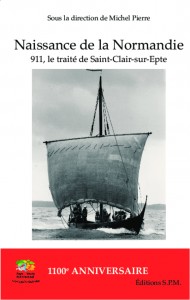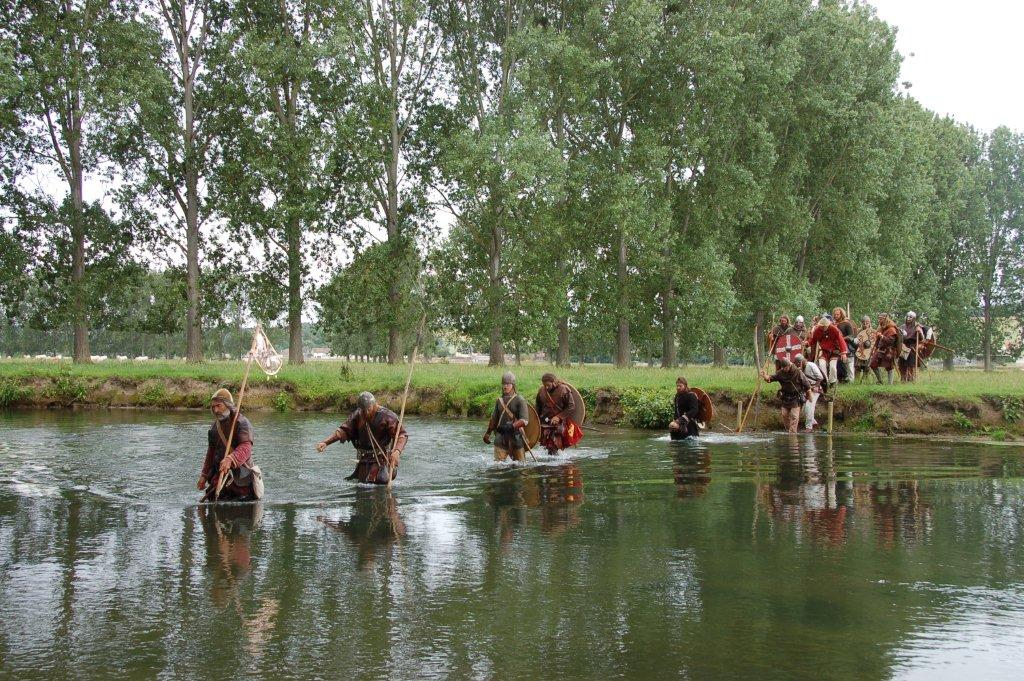BOOK REVIEW: In 2011 Normandy celebrated the treatise brokered between the French King and the Viking, Rollo, in 911
In 911 the French King, Charles the Simple, met with the Viking chieftain, Rollo at Saint-Clair-sur-Epte in order to sign a treaty, permitting the Vikings to settle in Normandy in return for their protection of the French Kingdom from the invasions of other Northmen (as the Vikings were called by the French). For a long time it was believed that the only existing source was a long and perhaps a bit farfetched description of the meeting and the negotiations in the French Cronicle of Dudo of St. Quentin. Hence historians have from time to time considered the treaty a myth. However, there does exist a document from 918, in which we are told that the king donate some land to the abbey of St. Germain-de Prés, except that part which “we have granted to the Northmen at the Seine, that is to say Rollo and his companions, in order for them to safeguard the kingdom.” [1]
Building on this, French politicians and historians took a deep breath in the beginning of the 21st century and declared their intention to celebrate the founding moment in 911 of the Duchy of Normandy by organising an anniversary full of festivities. Part of this consisted of a series of public lectures, where the French professors, who are the specialists on the history, archaeology and culture in Normandy in the 9th and 10th century presented the results of their latest research. Recently these papers have been published in a collection edited by Michel Pierre, who is vice-president in the Pays du Vexin (and a historian). The articles are written by Pierre Bauduin, Pierre Bouet, Caroline Bride, Gilles Deshayes, Jaques le Maho, Bruno lepeuple, Bruno Nardeaux and Elisabeth Ridel.
Anyone with the slightest knowledge of the early medieval history of Normandy, will know that these names vouches for quality. And as it is a French publication, the small book is annotated with footnotes and literature. Beginners may begin here.
The collection proper, stripped from its many introductions provided by local dignitaries, is introduced by Jacques le Maho, who was responsible for the archaeological excavations in Rouen between 1986 to 1993, which showed a major shift in the orientation of the city, turning parallel to the river. In his article he places the Viking incursions into Normandy in their context and shows how Rollo was not the first nor the only agent operating in the lush countryside up and down the Seine and its tributaries.
Next article is by Pierre Bouet, who goes into detail with the story about the treaty as it was told by Dudo of St. Quentin in his chronicle. Through a very dense reading he shows that earlier scholars, who disparaged Dudo, were wrong. Even though much is still questionable, his writings seem to be more worthy as a source than has hitherto been thought. Even the marriage of Rollo to Gisela, a daughter of Charles the Simple, which have often been believed to be sheer fantasy, has been lifted from obscurity. It now appears that Charles did have a daughter by that name (even though she must have died very young). In the end Bouet concludes that it is complicated to critically sift the information in Dudo in order to get a sense of what went on. But it is not deemed impossible.
Following this is a couple of articles considering the border between France and Normandy in the 10th – 12th century and a report of an archaeological investigation of a minor Carolingian village. The real prize, however goes to the article by Élisabeth Ridel, who writes about the Scandinavian linguistic inheritance of the Normans. 155 words are definitely of Scandinavian origin. To this should be added a minor collection of words, which could be of either Scandinavian or Anglo-Saxon or Germanic origin etc. As a service these words are listed in a supplement for anyone to peruse. Perhaps not much compared to the 500 words or so, which the Merovingians were able to export to Latin/Romance. Nevertheless, the words cover a wide spectrum of fields and show – if you draw them up – exactly where the Vikings seemed to interact with the local. Thus the existence of the word *bruman < brúdmaðr, acc bruðmann, which means “jeune marié” or bridegroom, nicely tells us that the Vikings married into the local families. The lack of the equivalent word for bride, brúðr, tells us that Viking males must have married French girls – and not the other way around! So much for later rumours about the wholesale immigration of both males, females, children and cattle.
All in all it is a very interesting collection of articles, well worth a read for anyone interested in keeping up with the latest development in the Viking History of Normandy. Later on other (and perhaps slightly more academic publications are expected (promised in the footnotes) but until then we may enjoy ourselves here.
Karen Schousboe
Naissance de la Normandie 911, le traité de Saint-Clair-sur-Epte
Ed. By Michel Pierre
SPM 2013, Kronos 69
ISBN 978 -2-336-66637-2
Distribution L’Harmattan www.harmattan.fr and amazon.com (kindle).
Featured Photo:
In the summer of 2011 a group of reenactors from Thorvald Aventure organized a reenactment of the treater of Saint Clair-Sur-Epte
_________
[1] …Praeter partem ipsius abbatiae quam animus Normannis Sequanensibus, uidelicet Rolloni suisque comities, pro tutelar regni. As quoted in: Early Normandy. By Lesley Abrams. In: Anglo-Norman Studies 35. Proceedings of the Battle Conference 2012. Edited by David Bates p. 45
